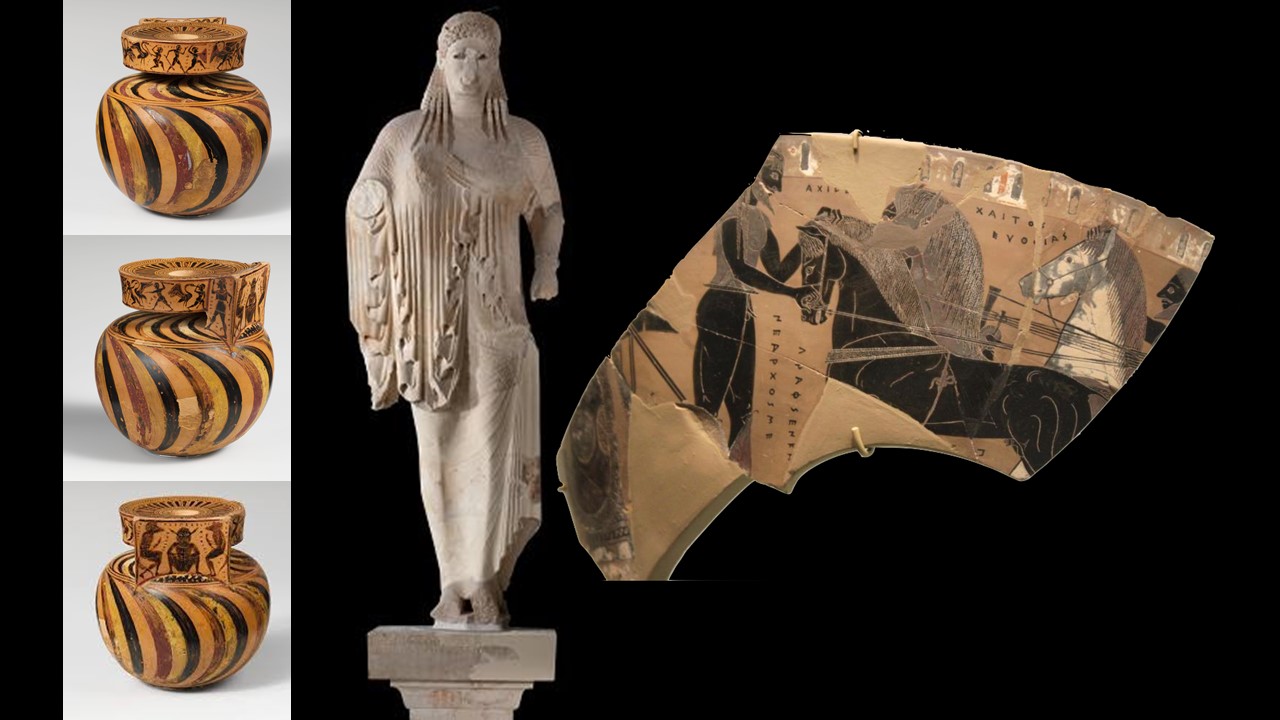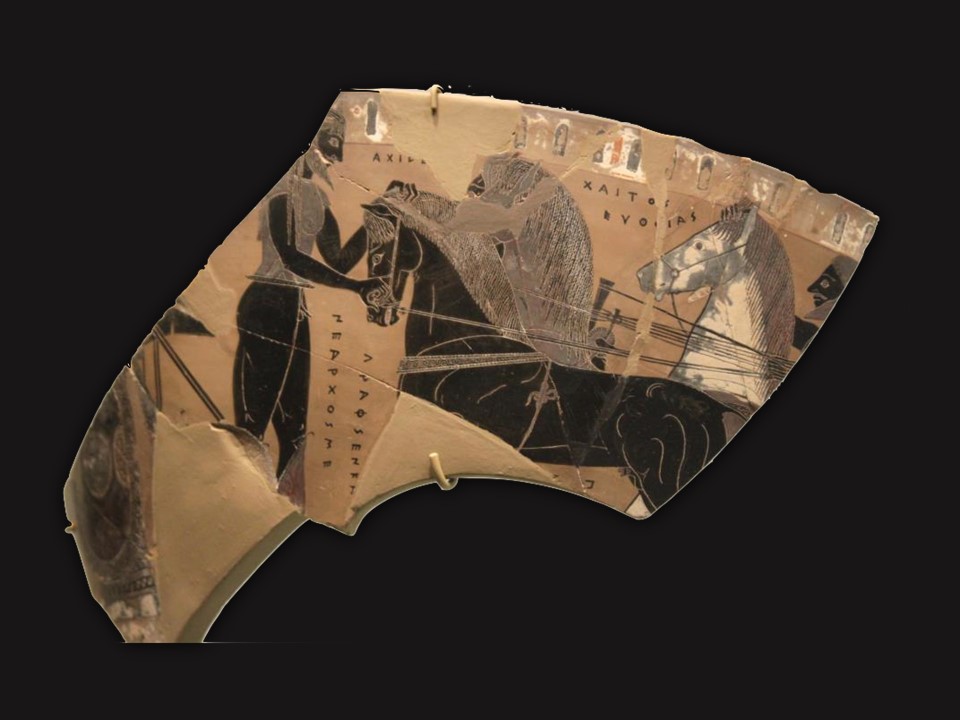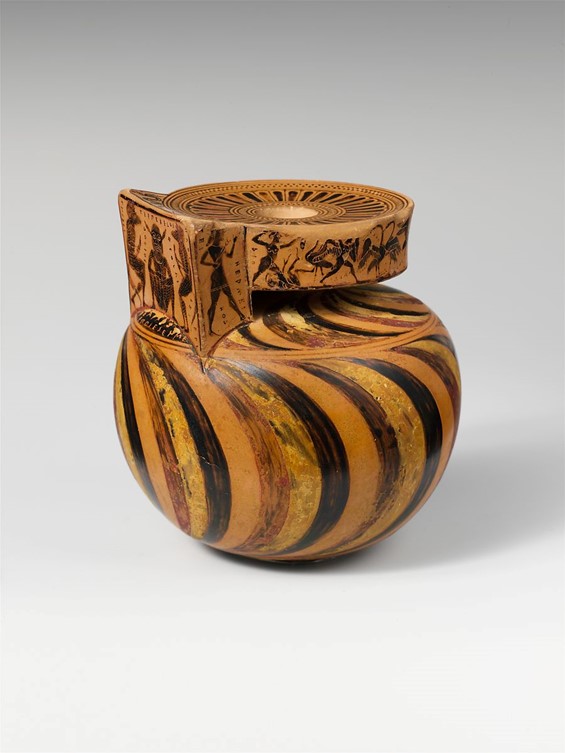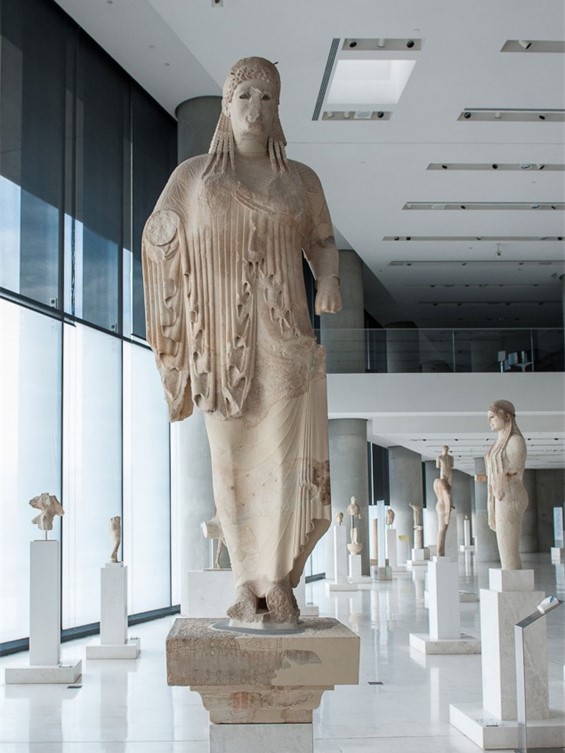
Archaic Black-Figure Terracotta fragment of a Kantharos (drinking cup) by Nearchos, Archaic – ca. 550 BC, 15,5 cm, National Archaeological Museum, Athens
Antenor Kore, 525-500 BC, Parian Marble, Acropolis Museum, Athens
In the words of Simonides of Ceos, “Painting is silent poetry, and poetry is painting with the gift of speech.” (Quoted by Plutarch, De Gloria Atheniensium 3.346f). I wonder if Nearchos, the celebrated Athenian painter and potter, was a poet at heart!
Looking at Attic Black-Figure pottery, you get the impression that sometime during the second quarter of the 6th century, an artistic revival takes place. The artists of the time, pottery makers and pottery painters show an exquisitely refined technique and draughtsmanship of a very high order indeed. Among them, Nearchos, potter and vase painter, stands at the very top.
Nearchos comes from Attica and is considered today a great master of the Black-Figure style. His career as a potter most probably started as a student in the workshop of Kleitias and Ergotimos, the famous creators of the François Vase. He lived and prospered in Athens, sometime between 570 and 555 BC, where he established a flourishing workshop. He raised two sons, Tleson and Ergoteles, who trained to become famous potters themselves. Later in his life, established, respected and wealthy, a “poet” at hart, he commissioned a beautiful Kore for the Acropolis of Athens, and acquired further admiration and fame.

A small ostracon of a Kantharos vase in the National Archaeological Museum at Athens was my introduction to his artistic abilities. I like how precise, dense and detailed his “incisions” are in depicting contour details and how the use of colour, white and purple enhances his composition. I also feel for the depicted story, the dialogue between Achilles and his god-sent horses… his fierce admonition “Xanthus and Balius, Podarge’s famous foals, this time think of a way to bring your master back alive when the fight is done, not leave him dead on the field, as you did brave Patroclus” and Xanthus’s devastating answer “This once, mighty Achilles, we will save you, yes, even though the hour of your doom draws nigh, nor indeed will we be the cause of your death even then, rather a mightier god and relentless Fate…” (Iliad, Rhapsody Τ) https://www.poetryintranslation.com/PITBR/Greek/Iliad19.php#anchor_Toc239246279

The small Aryballos at the MET is another Nearchos favourite of mine. This is a small, “intimate” item of great ergonomic qualities. Imagine… admiring it as it comfortably fits the palm of your hand, filled with your chosen perfumed oil! The shape is perfectly balanced and the design is rowdy and exotic… pygmies fighting cranes, satyrs, Hermes, Perseus and two tritons! Think… your new aryballos will be the talk of your fellow athletes in your favourite Palestra!!! https://www.metmuseum.org/art/collection/search/252451

The Antenor Kore was found, battered and in several fragments, during the 19th century excavations on the Athenian Acropolis, in the so-called Perserschutt, the “Persian debris” level. It is a late Archaic statue of a young girl, her long, auburn hair beautifully groomed in locks and curls, dressed in chiton and an Ionian Peplos, adorned with jewelry, smiling, happy to honour goddess Athena. Fragments of a Pentelic marble statue base identify Nearchos the Potter as the donor and Antenor, son of Eumares as the sculptor. The dedicatory inscription, translated, reads: Nearchos the potter dedicated this work as an offering to Athena / Antenor the son of Eumares made the statue.
If you still wonder whether Nearchos, the celebrated Athenian painter and potter, was a poet at heart! My answer would emphatically be… YES! https://museum.classics.cam.ac.uk/collections/casts/antenor-kore and https://www.theacropolismuseum.gr/sites/default/files/antinor_gr_0.pdf
For a student-friendly Activity Worksheet on Learning from Ancient Greek Pottery… Click HERE!